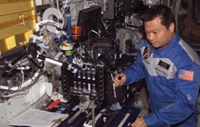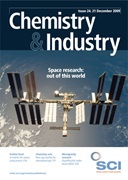Despite the myths about the lack of real scientific results from space exploration, Neil Eisberg discovers that a wealth of real research has been conducted by NASA and continues on the Space Station
There is a myth that the only real benefits from space research have been the non-stick frying pan and the ballpoint pen that can write underwater and upside down. It is of course exactly that: a myth. A host of innovations have resulted from space exploration. The US National Aeronautical & Space Administration (NASA), for example, has been issued over 6300 patents, nearly one in every 1000 patents ever granted by the US Patent Office since 1790.
Out of this world
While non-stick coatings actually predate the US space programme by many years – for example, PTFE was discovered by chance in 1938 – they were used by NASA in the construction of space suits. The fabrics developed for space suits have themselves spawned other new products and applications, including a permanent structure fabric, originally developed for the Apollo moon programme but produced by Birdair, a company based in New York, US, for tent-like structures. Weight for weight the material is stronger than steel. It is also translucent and can therefore reduce lighting requirements and be used for covering natural grass playing fields within structures like Houston’s Reliant Stadium in Texas.
Many other innovations, including the pressurised ballpoint pen, were developed by or on behalf of NASA. They have since been licensed to commercial organisations that have massproduced the result products, including the selfrighting inflatable dinghy developed for the Apollo moon landing programme in the 1960s. Today’s widely used cordless d-i-y tools are a spin-off from the Apollo programme and have returned to space to be used in constructing the International Space Station.
More recently NASA has been applying space technology to the production of algal biofuel through sewage treatment. The process, known as Omega, or Offshore Membrane Enclosures for Growing Algae, was described at the recent Algae Congress in Hamburg, Germany. Plastics osmotic containers filled with sewage floating in the ocean are used to cultivate algae to produce both fuel and clean water, which passes out through the membrane. The Omega bags are produced from semi permeable membranes that were developed to recycle astronauts’ wastewater on long space missions.
Continuing its focus on water recovery and treatment, NASA has invited fifth to eighth grade students in the US to participate in a waste water limitation and recycling design challenge covering the design and testing of systems that could be used for the future exploration of the moon. As with the Omega process, Earth-bound innovations are likely to result.
While a number of other innovations have resulted from NASA’s work on improving the lot of astronauts, much of its research is based on the availability of the micro-gravity environment in Earth orbit. The most recent Atlantis shuttle mission carried out a series of experiments on behalf of biotech firm Astrogenetix, aimed at the discovery of vaccines for a number of diseases including those caused by methicillin-resistant Staphylococcus aureus (MRSA). Astrogenetix, based in Austin, Texas, US, is focused on the discovery of therapeutics based on biomarkers and claims to be the first commercial biotech company to use this microgravity environment.
Fighting MRSA
MRSA causes 100,000 serious infections and 19,000 deaths annually in the US alone, a higher mortality rate than HIV/AIDS, emphysema or homicide. The MRSA ‘superbug’, once largely confined to hospitals, is now becoming prevalent in the community. Previous space flight studies of the bacteria demonstrated that growth of this organism in the microgravity environment elicits unique interactions in biological systems that do not occur on Earth, specifically changes in virulence.
This was the fourth time in 2009 that NASA’s shuttle fleet has carried experiments conducted by Astrogenetix. The company was looking to build on research from an earlier mission in August 2009 by focusing on a specific group of genes that have shown promise in the identification of a potential vaccine candidate.
‘Through our unique approach of conducting experiments in microgravity at the International Space Station, years may be eliminated from research and development to allow for fast-tracking of promising results,’ said ceo John Porter.
Astrogenetix has worked closely with NASA in an effort to fully utilise the International Space Station (ISS). Since its formation in early 2008, the company has flown experiments on six shuttle missions and is slated to fly on all remaining shuttle missions.
‘We’re proud to be part of the groundbreaking medical research that can be done in space,’ said Thomas B. Pickens, Astrogenetix chairman. ‘By utilising the incredible research capabilities of the ISS, we are at the forefront of solving worldwide medical problems like Staph infections or salmonella that afflict thousands of people across the globe.’
Student experiments
On the same November shuttle mission, an experiment developed by students at Texas Southern University in Houston was also flown. This study, funded as part of NASA’s University Research Center project, was also focused on how E. coli and B. subtilis bacteria grow in microgravity. ‘I’m thrilled that giving students the chance to design and research an experiment to fly in space is one of the tools we have at NASA to engage them in science, technology, engineering and mathematics,’ said NASA deputy administrator Lori Garver. ‘These young people are our future, and providing an opportunity to inspire them is a major part of our mission at NASA.’
In addition to supporting education, NASA also supports innovation through its Small Business Innovation Research programme (SBIR), which works with NASA’s mission directorates to competitively select projects that address NASA research and technology needs. So far, SBIR has benefited a wide range of NASA activities, including air traffic control systems, Earth observing spacecraft, the Space Shuttle, the International Space Station and the Mars rovers. Amongst the 152 most recent proposals selected for contract awards, the research areas covered include advanced aerospace adhesives that minimise ageing effects and increase the durability of aircraft, new approaches to fire suppression in space craft, technologies to monitor spacecraft crew health, and new instrumentation for mineralogical analysis.
Research didn’t stop during the grounding of the shuttle fleet following the Challenger disaster in 1986. NASA researchers at the Johnson Space Center were investigating the effects of microgravity on human tissues and therefore developed the rotating wall bioreactor to simulate effects of microgravity and allow human cells to proliferate in a three-dimensional form resembling growth within the human body rather than the conventional two-dimensional result of Petri dish culture. In 2002, a Houston-based biotech firm, BioCell Innovations, now known as Regenentech, acquired the licences for the NASA bioreactor for application in stem cell research. The company has since further developed the concept in cooperation with NASA and other organisations and has licensed the technology on a global basis.
Although NASA has been conducting research for much longer, the ISS is about to celebrate its 10th anniversary with well over 400 experiments being conducted in continuous research over that period. In 2010, construction of the station will be completed but earlier in 2009 ISS published a report of research during its first nine years of operation noting that the accomplishments provide hints about the value of a fully utilised completed facility.
Apart from the ongoing microbial research highlighted above, other highlights included a handheld device for the rapid detection of biological and chemical substances on surfaces on the station. The Lab-on-a-chip Application Development – Portable Test System (LOCAD-PTS) – was used with three different types of cartridges for the detection of endotoxin, a marker of gram-negative bacteria, glucan (fungi) and lipoteichoic acid (gram-positive bacteria, to provide results within 15 minutes. The further development of the system includes chips that can detect yeast, mould and gram-positive bacteria, identify environmental contaminants and perform health diagnostics.
Growing proteins in microgravity

Research on the ISS has also led to the patenting of a microparticle analysis system and method, which can be used in the pharmaceutical and chemical sectors. An experimental microencapsulation electrostatic processing system has also been shown to offer a new drug delivery approach and has since been developed to deliver microcapsules of antitumour drugs directly to tumour sites.
With the completion of the ISS research facility in 2010, the stage will be set for a greatly increased scientific return and the realisation of its full potential as a national and international laboratory.





